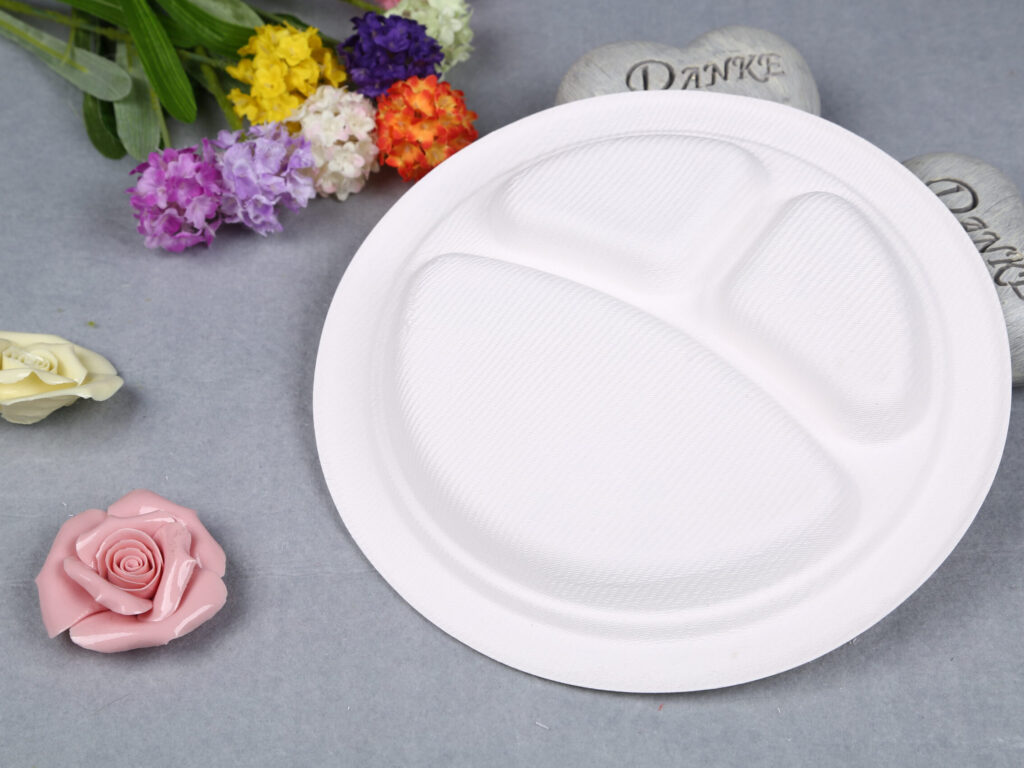1. Overview of the degradable plastic industry
1. Degradation process
Degradable plastic is the best solution for white pollution. Plastic is one of the most important materials in the modern industrial industry. However, the used waste plastic products have the characteristics of large quantity, wide distribution, and difficult to recycle. This has formed a "white pollution" problem that is of great concern to the world, which not only pollutes the environment and harms the environment. Healthy, but also occupy valuable land resources.
In this case, degradable plastics came into being. Biodegradable plastics refer to plastics whose products can meet the performance requirements of use with their various properties and remain unchanged during the storage period. After use, they can be degraded into environmentally sound substances under natural environmental conditions. They can be treated by composting. After being transformed into fertilizer, carbon dioxide and water, after planting sugar or starch-containing crops, it can be transformed into organic molecules for the production of polymer materials through fermentation or chemical processing. Such a degradable cycle can greatly reduce the impact of waste plastics on the environment, and it is also an effective way to achieve resource recycling and utilization.
2. Classification status
Degradable plastics can be classified by the way of degradation or the difference in raw materials. According to the classification of degradation methods, degradable plastics can be divided into four categories: biodegradable plastics, light-degradable plastics, light and biodegradable plastics, and water-degradable plastics. At present, the technologies for photodegradable plastics and photo- and biodegradable plastics are still immature, and there are few products on the market. Most of the degradable plastics mentioned are biodegradable plastics and water-degradable plastics. According to the division of raw materials, degradable plastics can be divided into bio-based degradable plastics and petroleum-based degradable plastics.
Classification status of degradable plastics
From a performance point of view, various degradable plastics have their own advantages and disadvantages, and generally need to be modified or compounded before use. The properties of PBAT, PBS and PHA are relatively similar, mainly because the monomer molecules constituting these materials are similar in structure, but are very different from the lactic acid constituting PLA. At present, the degradable plastic products used on a large scale on the market have been modified or compounded. Among them, PBAT is mainly used in combination with PLA. For example, the degradable plastic bags used on a large scale in supermarkets are composite materials of PLA and PBAT.
2. Analysis of Degradable Plastics Industry Chain and Driving Structure
In terms of the industrial chain, the upstream raw materials of degradable plastics mainly include PLA (polylactic acid), PHA (polyhydroxyalkanoate), PGA, PBS (polybutylene succinate), PBAT (polyadipate Butylene phthalate), PCL (polycaprolactone), etc.; midstream products mainly include tableware, film, film paper, express bags, clothing, plastic tape, 3D printing materials, etc.; downstream are mainly used in packaging, agriculture, 3D Printing, modern medicine, textile industry, etc.
Degradable plastic industry chain map
1. Upstream raw materials
At present, my country's biodegradable plastics are mainly biodegradable plastics. As far as the upstream supply is concerned, take the output of corn as an example. The data shows that my country’s corn production is stable at about 255-265 million tons from 2015 to 2020, and corn is mainly used in feed consumption, followed by industrial consumption (accounting for about 25%). At the same time, aging corn can also be used as a raw material for production. From a point of view, the supply of raw materials for biodegradable plastics is relatively stable, laying a raw material foundation for the development of biodegradable plastics in my country.
2. Downstream demand-driven
Take takeaway as an example. With the emergence of the foreign sales industry in my country, the demand for packaging plastics is rising rapidly. The market size of my country's food delivery industry has increased from 21.68 billion yuan in 2011 to 664.62 billion yuan in 2020, with a CAGR of 46.27% and a user scale of 456 million. As takeaways widely use disposable tableware, involving plastic products such as bags, bowls, soup spoons and soup cups, this has greatly increased the use of plastic products. In the future, with the further improvement of policy requirements, degradable plastics will completely replace ordinary plastic bags in the future, and the market prospect is broad.
3. Policy-driven
In 2020, my country has successively issued specific policies in various areas and fields, and formulated clear targets and standards for banning plastics, which reflects the implementation of my country's plastic pollution control. my country's plastic ban policy mainly focuses on the field of disposable and non-recyclable plastics, including four major categories of express packaging, plastic tableware, agricultural films and plastic shopping bags, which are also the main alternative areas for degradable plastics to traditional plastics.
China's plastic pollution work target by the end of 2020
3. Current status of the biodegradable market
1. Market size
Benefiting from the promotion of national policies, data show that my country's biodegradable plastics market reached 16.2 billion yuan in 2019. As market demand continues to grow, the government has promoted a further increase in the penetration of biodegradable plastics. It will exceed 20.9 billion yuan annually.
2. Market structure
The global biodegradable plastics market is dominated by starch-based, PLA, and PBAT. The currently widely used degradable materials include starch-based plastics, PLA, PBAT, PBS, PHA, etc. Data shows that the total global production capacity of degradable plastics in 2019 is about 1.077 million tons. Among them, the production capacity of starch-based plastics is 449,400 tons, accounting for 38.4% of the global production capacity of degradable plastics. PLA and PBAT account for 25.0% and 24.1%, respectively. In the second and third place.
3. Cost comparison
From a cost perspective, the cost of PLA is slightly higher than that of PBAT in the past five years. The PLA monomer raw material lactic acid is mainly produced by the fermentation of corn and other food crops. In recent years, the domestic price of lactic acid has been relatively stable, and the production cost of lactic acid is relatively high. The complete cost of a typical industrial-scale PLA product is about 16,000 yuan/ton. Due to the relatively low price of raw materials, the complete cost of PBAT is lower than that of mainstream degradable plastics, about 13,000 yuan/ton. It has a competitive advantage and a high degree of industrialization. The production scale of PCL and PHA is obviously on the small side. Domestic imports are the mainstay and they have not yet been industrialized. On the whole, the current complete cost of degradable plastics is still relatively high, but with the implementation of the wider and stricter “plastic ban” policy, the cost of degradable plastics will not restrict its development. Plastic packaging Paid use will become the new normal for merchants to pass on costs to consumers.
4. Competitive landscape of biodegradable plastics
Judging from the current production capacity of biodegradable plastics and the production capacity under construction, the current domestic biodegradable plastic companies in the first echelon include Huafeng New Materials, Jindan Technology and Lai Run New Materials. The second echelon is Xinjiang Lanshan Tunhe, Kingfa Technology, etc., of which Kingfa Technology mainly occupies a leading position in the PBAT and PSB industries. The third echelon is mainly Beijing Chemical Industry Group and Anhui Fengyuan Group.
Related report: "Research Report on Development Monitoring and Investment Strategic Planning of China's Degradable Plastics Industry from 2021-2026" issued by Huajing Industry Research Institute;
The raw materials for PBAT production are adipic acid (AA), PTA and BDO. The raw materials are easier to obtain and the production technology is more mature. The existing production capacity is slightly higher than that of PLA. China is the country with the highest PBS/PBAT production capacity in the world. The current domestic production capacity is 28.1. 10,000 tons/year. Kingfa Technology is a leading domestic PBS/PBAT enterprise with an existing production capacity of 120,000 tons/year, and another 180,000 tons of production capacity is under construction. In addition, Xinjiang Wangjinglong, Hengli Petrochemical, Xinjiang Lanshan Tunhe and other enterprises are actively deploying petroleum-based biodegradable plastics.
5. Global trend of degradable plastics
In order to control white pollution, countries around the world have successively introduced a number of policies in recent years, adopting methods such as levying plastic value-added tax or fees, banning or restricting the use of traditional plastic bags, and legislating to promote degradable plastics. Among them, developed countries and regions in Europe and the United States started earlier. Italy completely banned the use of non-biodegradable plastics in 2011. In 2002, the United States required states to formulate biodegradable agricultural plastics. Most Asian countries began to implement plastic restrictions in 2019. make. my country has also adopted a number of measures. In 2007, it issued a "plastic limit order", in 2018 it issued the first national standard for biodegradable agricultural mulch film, and in 2020, it issued the "Opinions on Further Strengthening Plastic Pollution Control". In many scenarios Prohibit non-degradable plastics and realize the transition from "plastic restriction" to "plastic ban". According to a survey by the United Nations Environment Programme, there are currently at least 67 countries or regions restricting the use of disposable plastic products in the world. In 2019, there are more than 15 countries in the world that have newly launched restrictions on plastics. With the gradual implementation of the global and China's plastic restriction and ban policies, degradable plastics have a huge space for substitution of traditional plastics by virtue of their short-term degradation and environmentally friendly advantages.
 Why “It Depends” on the Material
Why “It Depends” on the Material Benefits of Microwave-Safe Compostable Plates
Benefits of Microwave-Safe Compostable Plates A Quick Note on Composting
A Quick Note on Composting





